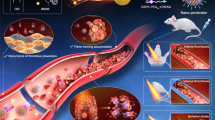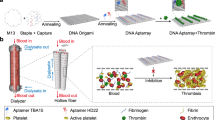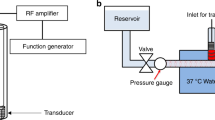Abstract
Thrombosis is a leading global cause of death, in part due to the low efficacy of thrombolytic therapy. Here, we describe a method for precise delivery and accurate dosing of tissue plasminogen activator (tPA) using an intelligent DNA nanodevice. We use DNA origami to integrate DNA nanosheets with predesigned tPA binding sites and thrombin-responsive DNA fasteners. The fastener is an interlocking DNA triplex structure that acts as a thrombin recognizer, threshold controller and opening switch. When loaded with tPA and intravenously administrated in vivo, these DNA nanodevices rapidly target the site of thrombosis, track the circulating microemboli and expose the active tPA only when the concentration of thrombin exceeds a threshold. We demonstrate their improved therapeutic efficacy in ischaemic stroke and pulmonary embolism models, supporting the potential of these nanodevices to provide accurate tPA dosing for the treatment of different thromboses.
This is a preview of subscription content, access via your institution
Access options
Access Nature and 54 other Nature Portfolio journals
Get Nature+, our best-value online-access subscription
$29.99 / 30 days
cancel any time
Subscribe to this journal
Receive 12 print issues and online access
$259.00 per year
only $21.58 per issue
Buy this article
- Purchase on Springer Link
- Instant access to full article PDF
Prices may be subject to local taxes which are calculated during checkout





Similar content being viewed by others
Data availability
All the data supporting the findings of this study are available within the article and its supplementary information files and from the corresponding author upon reasonable request. Source data are provided with this paper.
References
Mackman, N. Triggers, targets and treatments for thrombosis. Nature 451, 914–918 (2008).
Furie, B. & Furie, B. C. Mechanisms of thrombus formation. N. Engl. J. Med. 359, 938–949 (2008).
Emberson, J. et al. Effect of treatment delay, age, and stroke severity on the effects of intravenous thrombolysis with alteplase for acute ischaemic stroke: a meta-analysis of individual patient data from randomised trials. Lancet 384, 1929–1935 (2014).
Derex, L. & Nighoghossian, N. Thrombolysis, stroke-unit admission and early rehabilitation in elderly patients. Nat. Rev. Neurol. 5, 506–511 (2009).
Betts, K. A. et al. Real-world outcomes of acute ischemic stroke treatment with intravenous recombinant tissue plasminogen activator. J. Stroke Cerebrovasc. 26, 1996–2003 (2017).
Hassanpour, S. et al. Thrombolytic agents: nanocarriers in controlled release. Small 16, e2001647 (2020).
Xu, J. C., Zhang, Y. L. & Nie, G. J. Intelligent antithrombotic nanomedicines: progress, opportunities, and challenges. View 2, 20200145 (2021).
Marder, V. J. & Novokhatny, V. Direct fibrinolytic agents: biochemical attributes, preclinical foundation and clinical potential. J. Thromb. Haemost. 8, 433–444 (2010).
Zenych, A., Fournier, L. & Chauvierre, C. Nanomedicine progress in thrombolytic therapy. Biomaterials 258, 120297 (2020).
Xu, J. C. et al. Engineered nanoplatelets for targeted delivery of plasminogen activators to reverse thrombus in multiple mouse thrombosis models. Adv. Mater. 32, e1905145 (2020).
Hu, J. N. et al. Tissue plasminogen activator-porous magnetic microrods for targeted thrombolytic therapy after ischemic stroke. ACS Appl. Mater. Interfaces 10, 32988–32997 (2018).
Wang, S. Y. et al. Accelerating thrombolysis using a precision and clot-penetrating drug delivery strategy by nanoparticle-shelled microbubbles. Sci. Adv. 6, eaaz8204 (2020).
Korin, N. et al. Shear-activated nanotherapeutics for drug targeting to obstructed blood vessels. Science 337, 738–742 (2008).
Zhao, Y. et al. Biomimetic fibrin-targeted and H2O2-responsive nanocarriers for thrombus therapy. Nano Today 35, 100986 (2020).
Mei, T. et al. Encapsulation of tissue plasminogen activator in pH-sensitive self-assembled antioxidant nanoparticles for ischemic stroke treatment—synergistic effect of thrombolysis and antioxidant. Biomaterials 215, 119209 (2019).
Rabanel, J. M. et al. Nanoparticle heterogeneity: an emerging structural parameter influencing particle fate in biological media? Nanoscale 11, 383–406 (2019).
Li, S. P. et al. A DNA nanorobot functions as a cancer therapeutic in response to a molecular trigger in vivo. Nat. Biotechnol. 36, 258–264 (2018).
Li, J., Fan, C. H., Pei, H., Shi, J. Y. & Huang, Q. Smart drug delivery nanocarriers with self-assembled DNA nanostructures. Adv. Mater. 25, 4386–4396 (2013).
He, L. C., Mu, J., Gang, O. & Chen, X. Y. Rationally programming nanomaterials with DNA for biomedical applications. Adv. Sci. 8, 2003775 (2021).
Hu, Q. Q., Li, H., Wang, L. H., Gu, H. Z. & Fan, C. H. DNA nanotechnology-enabled drug delivery systems. Chem. Rev. 119, 6459–6506 (2019).
Liu, S. L. et al. A DNA nanodevice-based vaccine for cancer immunotherapy. Nat. Mater. 20, 421–430 (2020).
Nakatsuka, M. A., Mattrey, R. F., Esener, S. C., Cha, J. N. & Goodwin, A. P. Aptamer-crosslinked microbubbles: smart contrast agents for thrombin-activated ultrasound imaging. Adv. Mater. 24, 6010–6016 (2012).
Rothemund, P. W. K. Folding DNA to create nanoscale shapes and patterns. Nature 440, 297–302 (2006).
Mutch, N. J., Thomas, L., Moore, N. R., Lisiak, K. M. & Booth, N. A. TAFIa, PAI-1 and α2-antiplasmin: complementary roles in regulating lysis of thrombi and plasma clots. J. Thromb. Haemost. 5, 812–817 (2007).
Hu, Q. Y. et al. Engineered nanoplatelets for enhanced treatment of multiple myeloma and thrombus. Adv. Mater. 28, 9573–9580 (2016).
Chapin, J. C. & Hajjar, K. A. Fibrinolysis and the control of blood coagulation. Blood Rev. 29, 17–24 (2015).
Mann, K. G. Thrombin generation in hemorrhage control and vascular occlusion. Circulation 124, 225–235 (2011).
Brummel-Ziedins, K. E., Vossen, C. Y., Butenas, S., Mann, K. G. & Rosendaal, F. R. Thrombin generation profiles in deep venous thrombosis. J. Thromb. Haemost. 3, 2497–2505 (2005).
Wolberg, A. S. & Campbell, R. A. Thrombin generation, fibrin clot formation and hemostasis. Transfus. Apher. Sci. 38, 15–23 (2008).
Tanaka, K. A., Key, N. S. & Levy, J. H. Blood coagulation: hemostasis and thrombin regulation. Anesth. Analg. 108, 1433–1446 (2009).
Del Zoppo, G. J., Saver, J. L., Jauch, E. C. & Adams, H. P. Jr. Expansion of the time window for treatment of acute ischemic stroke with intravenous tissue plasminogen activator: a science advisory from the American Heart Association/American Stroke Association. Stroke 40, 2945–2948 (2009).
Schwartz, R. S. et al. Microemboli and microvascular obstruction in acute coronary thrombosis and sudden coronary death: relation to epicardial plaque histopathology. J. Am. Coll. Cardiol. 54, 2167–2173 (2009).
Brown, W. R., Moody, D. M., Challa, V. R., Stump, D. A. & Hammon, J. W. Longer duration of cardiopulmonary bypass is associated with greater numbers of cerebral microemboli. Stroke 31, 707–713 (2000).
Pongmoragot, J. et al. Pulmonary embolism in ischemic stroke: clinical presentation, risk factors, and outcome. J. Am. Heart Assoc. 2, e000372 (2013).
Xu, X. et al. Self-regulated hirudin delivery for anticoagulant therapy. Sci. Adv. 6, eabc0382 (2020).
Mutch, N. J., Robbie, L. A. & Booth, N. A. Human thrombi contain an abundance of active thrombin. Thromb. Haemost. 86, 1028–1034 (2001).
Xu, J. P. et al. Sequentially site-specific delivery of thrombolytics and neuroprotectant for enhanced treatment of ischemic stroke. ACS Nano 13, 8577–8588 (2019).
Acknowledgements
This work was supported by the Natural Science Foundation of Jiangsu Province, major project (BK20212012 (L.W.)), the NSFC (62288102 (L.W.), 21922408 (J.C.), 22274081 (J.C.), 22277058 (Y.G.), 21991134 (C.F.), T2188102 (C.F.)), the Natural Science Foundation of Jiangsu Province (BE2023839 (J.C.)), and the New Cornerstone Science Foundation (C.F.).
Author information
Authors and Affiliations
Contributions
J.C., Y.G. and L.W. conceived the project. J.C., Y.G., J.Y., S.W., and J.W. designed the experiments. J.Y., S.W. and J.W. carried out the experiments. S.W., J.W. and Y.Z. performed the in vivo experiments. J.Y., S.W., J.W., J.C. and Y.G. collected and analysed the data. Y.G., J.C., J.Y., S.W., C.F. and L.W. wrote the manuscript. All authors discussed the results and commented on the manuscript.
Corresponding authors
Ethics declarations
Competing interests
The authors declare no competing interests.
Peer review
Peer review information
Nature Materials thanks Guangjun Nie, Hao Yan and the other, anonymous, reviewer(s) for their contribution to the peer review of this work.
Additional information
Publisher’s note Springer Nature remains neutral with regard to jurisdictional claims in published maps and institutional affiliations.
Supplementary information
Supplementary Information
Supplementary Figs. 1–52, Tables 1 and 2, Note and unprocessed gels.
Supplementary Data
Source Data for Supplementary Figure.
Source data
Source Data Fig. 1
Statistical source data and unprocessed gels.
Source Data Fig. 1
Unprocessed gels.
Source Data Fig. 2
Statistical source data.
Source Data Fig. 3
Statistical source data.
Source Data Fig. 4
Statistical source data.
Source Data Fig. 5
Statistical source data.
Rights and permissions
Springer Nature or its licensor (e.g. a society or other partner) holds exclusive rights to this article under a publishing agreement with the author(s) or other rightsholder(s); author self-archiving of the accepted manuscript version of this article is solely governed by the terms of such publishing agreement and applicable law.
About this article
Cite this article
Yin, J., Wang, S., Wang, J. et al. An intelligent DNA nanodevice for precision thrombolysis. Nat. Mater. (2024). https://doi.org/10.1038/s41563-024-01826-y
Received:
Accepted:
Published:
DOI: https://doi.org/10.1038/s41563-024-01826-y



